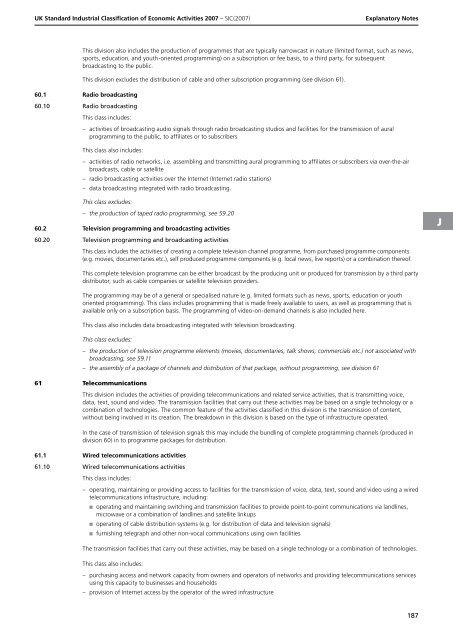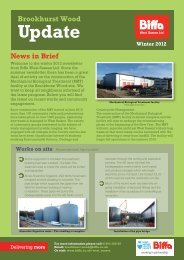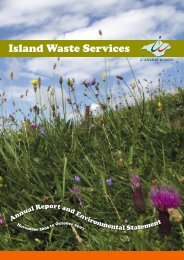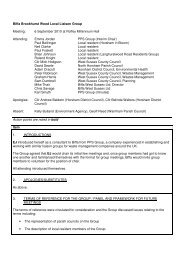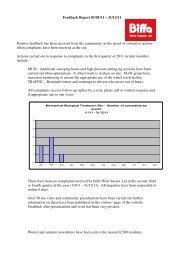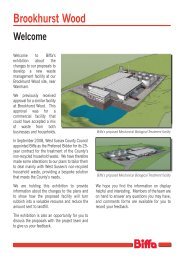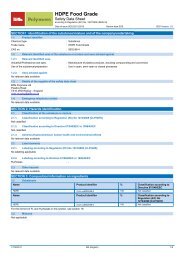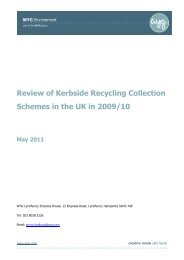detailed explanation for each SIC code - Biffa
detailed explanation for each SIC code - Biffa
detailed explanation for each SIC code - Biffa
Create successful ePaper yourself
Turn your PDF publications into a flip-book with our unique Google optimized e-Paper software.
UK Standard Industrial Classification of Economic Activities 2007 – <strong>SIC</strong>(2007)<br />
Explanatory Notes<br />
This division also includes the production of programmes that are typically narrowcast in nature (limited <strong>for</strong>mat, such as news,<br />
sports, education, and youth-oriented programming) on a subscription or fee basis, to a third party, <strong>for</strong> subsequent<br />
broadcasting to the public.<br />
This division excludes the distribution of cable and other subscription programming (see division 61).<br />
60.1 Radio broadcasting<br />
60.10 Radio broadcasting<br />
This class includes:<br />
–<br />
activities of broadcasting audio signals through radio broadcasting studios and facilities <strong>for</strong> the transmission of aural<br />
programming to the public, to affiliates or to subscribers<br />
This class also includes:<br />
–<br />
–<br />
–<br />
activities of radio networks, i.e. assembling and transmitting aural programming to affiliates or subscribers via over-the-air<br />
broadcasts, cable or satellite<br />
radio broadcasting activities over the Internet (Internet radio stations)<br />
data broadcasting integrated with radio broadcasting.<br />
This class excludes:<br />
–<br />
the production of taped radio programming, see 59.20<br />
60.2 Television programming and broadcasting activities<br />
60.20 Television programming and broadcasting activities<br />
This class includes the activities of creating a complete television channel programme, from purchased programme components<br />
(e.g. movies, documentaries etc.), self produced programme components (e.g. local news, live reports) or a combination thereof.<br />
J<br />
This complete television programme can be either broadcast by the producing unit or produced <strong>for</strong> transmission by a third party<br />
distributor, such as cable companies or satellite television providers.<br />
The programming may be of a general or specialised nature (e.g. limited <strong>for</strong>mats such as news, sports, education or youth<br />
oriented programming). This class includes programming that is made freely available to users, as well as programming that is<br />
available only on a subscription basis. The programming of video-on-demand channels is also included here.<br />
This class also includes data broadcasting integrated with television broadcasting.<br />
This class excludes:<br />
–<br />
–<br />
the production of television programme elements (movies, documentaries, talk shows, commercials etc.) not associated with<br />
broadcasting, see 59.11<br />
the assembly of a package of channels and distribution of that package, without programming, see division 61<br />
61 Telecommunications<br />
This division includes the activities of providing telecommunications and related service activities, that is transmitting voice,<br />
data, text, sound and video. The transmission facilities that carry out these activities may be based on a single technology or a<br />
combination of technologies. The common feature of the activities classified in this division is the transmission of content,<br />
without being involved in its creation. The breakdown in this division is based on the type of infrastructure operated.<br />
In the case of transmission of television signals this may include the bundling of complete programming channels (produced in<br />
division 60) in to programme packages <strong>for</strong> distribution.<br />
61.1 Wired telecommunications activities<br />
61.10 Wired telecommunications activities<br />
This class includes:<br />
–<br />
operating, maintaining or providing access to facilities <strong>for</strong> the transmission of voice, data, text, sound and video using a wired<br />
telecommunications infrastructure, including:<br />
■ operating and maintaining switching and transmission facilities to provide point-to-point communications via landlines,<br />
microwave or a combination of landlines and satellite linkups<br />
■ operating of cable distribution systems (e.g. <strong>for</strong> distribution of data and television signals)<br />
■ furnishing telegraph and other non-vocal communications using own facilities<br />
The transmission facilities that carry out these activities, may be based on a single technology or a combination of technologies.<br />
This class also includes:<br />
– purchasing access and network capacity from owners and operators of networks and providing telecommunications services<br />
using this capacity to businesses and households<br />
– provision of Internet access by the operator of the wired infrastructure<br />
187


